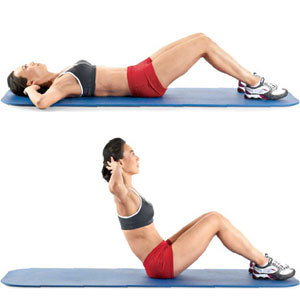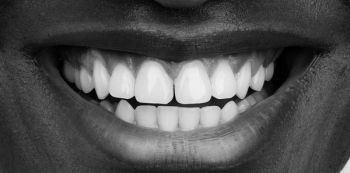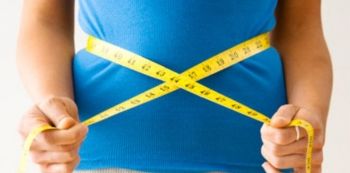
Part 1 of 5: Jump-Starting Your Metabolism
Eat breakfast.It might seem counterproductive to eat if you're trying to lose weight, but studies show that eating breakfast within an hour of waking up keeps your insulin levels steadier and your LDL cholesterol levels lower.
- Eat breakfast around the same time each day. If you tend to sleep in on weekends, eat as soon as you wake up.
- Consider including protein and high-fiber foods (eggs, peanut butter, fresh fruit and vegetables) for breakfast — they take longer to process than refined sugars and complex carbs so you'll feel full throughout the morning.
- Avoid making sugary cereals, waffles, pancakes, French toast, breakfast pastries or instant oatmeal the sole focus of your breakfast. If you must splurge and eat something with refined sugars, balance it with protein or fiber.
Decompress.(release stress).Research indicates that the secretion of cortisol (a hormone your body produces during times of stress) is correlated with an increase in belly fat. Some strategies for combating everyday stress:
- Enough sleep. Most adults need at least 7 hours of sleep every night to function properly.
- Set aside time to relax. Even if it's only 15 minutes on your lunch break, find time to simply close your eyes, breathe deeply, and forget your worries.
- Keep your stressors away from your sleeping area. If possible, don't work or do anything stressful in the bedroom. That the area should be reserved for rest/relaxation, and resolve to leave your worries behind as soon as you step into that room.
- Get a pedometer and try to increase the number of daily steps you take.
- Take stairs instead of elevators; walk instead of driving.
- Stand up and walk for 30 steps every 30 minutes. If you have a sedentary job, consider getting a treadmill desk.
Drink plenty of water.Studies suggest that consistently drinking water throughout the day can lead to a more active metabolism, regardless of dieting. Drinking more water also helps your body flush out waste/toxins and improves your overall health.
- Aim to drink an 8 cups. glass of water 8 times per day.
- Carry a water bottle so that you can drink whenever you feel thirsty.
- Know how to tell when you're sufficiently hydrated. You'll know you're drinking enough water when your urine runs almost clear. If it's still yellow, drink up.
- Significantly reduce alcohol, sugary drinks (like Coke, 7-Up, Pepsi and all the diet drinks), and carbonated beverages.
Part 2 of 5: Exercising for Fat Loss

Exercise in small bursts.Research shows that interval training, or alternating short bursts of energy with brief resting periods, can improve muscle and build endurance more quickly than traditional exercise.
- Sprint. Run as fast and as far as you can for 20 seconds, then slow to a walk until you catch your breath. Repeat for 10 minutes.
- Set a treadmill, elliptical or stationary bike for interval training. Most modern exercise equipment can be set to an interval training mode, which significantly increases the difficulty of the exercise for short periods of time.
- Take quick walks. Fit some exercise into your work day and take 5-minute power walks. Take long strides and keep a brisk pace, or try going up and down stairs
basic exercise to help u build a stronger ABS(stomach core or packs) and to lose some of that waist fat;
Do squats. Stand with your feet 8-9 inches apart, extend your arms in front of you and squat your hips backward. Do four sets of 15 to 20 squats, working several minutes at a time.
Stretch the sides of your waist. Stand up straight, with your feet hip-width apart. Put your right hand on your right hip, and lift your left arm straight up, so that your palm faces to the right. Keeping your legs centered, lean to the right and "reach" over with your left arm, stretching your left side. Do 3 to 5 times on each side.
push ups. Get into the position for doing a push up/press up. Rest on your elbows and always keep your eyes to the floor. Pull your stomach muscles in tight, imagining them going to your backbone. As you do this, your bottom should be down and your back straight. Hold this position for as long as it feels comfortable. During the holding period, don't arch your back but keep it as straight as possible. If it feels too hard at first, allow your knees to form a resting platform. Aim to hold the position for 30 seconds and repeat this exercise 3 to 5 times.
Part 3 of 5: Dieting for Fat Loss.
- Remember that it takes a 3500-calorie deficit to lose one pound of fat. That is, you have to either burn off 3500 calories through exercise or eat 3500 calories less than you burn in a week.
- Aim to lose a maximum of two pounds per week. Losing any more than that can be unhealthy and leads to a cycle of "crash" dieting, in which you rapidly gain back any lost weight.
- Keep a food diary. Most people tend to underestimate how much they eat. Get an honest assessment of your eating habits by writing down everything you consume for a week. Utilize an online calorie calculator, and figure out roughly how many calories you're consuming in a day. From there, see what you can afford to cut.
- Try a diet in which you consume 2200 calories (men) or 2000 calories (women) per day. This should cause a deficit sufficient for you to lose one or two pounds per week, depending on your activity level.
Get more fiber in your diet.Soluble fiber (such as that found in apples, oats, and cherries) lowers insulin levels which can speed up the burning of visceral belly fat.
- Add fiber to your diet slowly. If you are currently getting 10 grams of fiber a day, don't jump to 35 grams of fiber the next day. The natural bacteria in your digestive system requires time to adapt to your new fiber intake.
- Eat the skin on your fruits and vegetables. Incorporating more fruits and vegetables into your diet adds fiber, but only if you eat the skin, as that's where all the fiber is. Don't peel those apples before you eat them. With potatoes, leave the skin on (with baked or mashed potatoes) or if you peel them, make snacks of them, such as baked garlic Parmesan peels. Keeping the skin on potatoes when cooking them helps keep more vitamins/minerals in the flesh. (Just don't eat any parts of skin that are green.)
- Eat more split pea soup. Split peas are a fiber "power food". Just one cup of them contains 16.3 grams of protein.
Part 4 of 5: Measuring Progress

- Wrap a soft tape measure around the thinnest part of your waist at the level of your navel. Note the measurement.
- Wrap the tape measure around the widest part of your hips, where you can feel a bony protrusion about 1/3 of the way from the top of the hipbone. Note the measurement.
- Divide your waist measurement by your hip measurement.
- Know what's healthy. Women should have a ratio of 0.8 or below; men should be at 0.9 or lower.
Part 5 of 5: Staying Motivated.
Comments (0)
📌 By commenting, you agree to follow these rules. Let’s keep HowweBiz a safe and vibrant place for music lovers!












